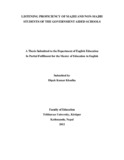Please use this identifier to cite or link to this item:
https://elibrary.tucl.edu.np/handle/123456789/337| Title: | Listening Proficiency of Majhi and Non-Majhi Students of the Government Aided Schools |
| Authors: | Khadka, Dipak Kumar |
| Keywords: | Listening;Government;Schools;Master |
| Issue Date: | 2012 |
| Publisher: | Central Department of Education English |
| Abstract: | This research study entitled 'Listening Proficiency of Majhi and Non-MajhiStudents of the Government Aided Schools'presents the picture of the listeningproficiency of grade 10 students. The main objectives of the study were to find outand compare the listening proficiency of Majhi and Non-Majhi students of grade10 among government aided schools.64 students of grade 10 were the samplepopulation. There were 16 students selected from each school. Secondary sourcessuch as books, magazines, thesis etc. were consulted.It was found that the averagelistening proficiency of Majhi studentswas 46percentwhereas the averagelistening proficiently of Non Majhi studentswas 52percent.The overall listeningproficiency of grade 10 studentswas 49.14percent.It was found that the non-Majhi students were more proficient than the Majhi students studying ingovernment aided schools. Similarly,the boys were found better at listening thangirl at all. It was also identified that due to lack of physical facilities,teachingmaterials, students poor English background and not asking listening test in theterminal as well as in the final examination were the obstacles in obtaining thehigher Proficiency.Similarly, the average proficiency in listening comprehensionof grade 10 was around 50% where the boys were more proficient than girls. This thesis consists of four chapters: Chapter one deals with general background,review of related literature, objective of the study, significant of the study anddefinition of the technical terms. Chapter two is concerned with the methodologyused in the collection of data. It includes sources of data, population of the study,sampling procedure, tools for data collection and limitation of the study.Chapterthree consists of analysis and interpretation of data. The data wereanalyzed on the basis of students, i.e. Majhistudent and non-Majhi studentsandon the basis ofthegender; i.e.boysand girls.The data were analyzed in terms of live and recordedmaterials. Chapter four presents the findingsof the study and therecommendations are made on the basis of the findings. |
| URI: | http://elibrary.tucl.edu.np:8080/jspui/handle/123456789/337 |
| Appears in Collections: | English Language Education |
Files in This Item:
| File | Description | Size | Format | |
|---|---|---|---|---|
| Cover(1).pdf | 47.19 kB | Adobe PDF |  View/Open | |
| Chapter(1).pdf | 186.92 kB | Adobe PDF |  View/Open |
Items in DSpace are protected by copyright, with all rights reserved, unless otherwise indicated.
